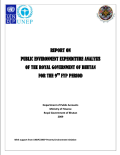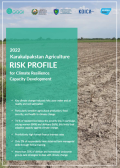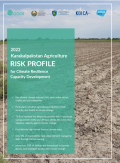
The scope of this study includes a review of public expenditure in the environment and natural resources sector, encompassing expenditure incurred by ministries, government departments and other agencies, and the local administration at the Dzongkhag and Geog levels on environment-related interventions along with all donor-supported projects of the environment sector.

This report encapsulates the key takeaways from the Workshop held in Bhutan with two main objectives, namely, 1) to take stock of environmental mainstreaming achievements to date, including Poverty-Environment Initiative (PEI) Phase I, and, 2) to discuss the challenges and opportunities of addressing environmental mainstreaming in the future.

This Public Environmental Expenditure Review (PEER) covers the first two financial years of the 10th Five Year Plan (FYP) (2008/09 and 2009/2010) and also draws on the experience from the 2009 PEER covering the 9th FYP. The PEER, therefore, provides a basis for the Royal Government of Bhutan (RGoB) to determine how the public expenditures are reflecting the development objectives for the environment and natural resources.

The 2022 Karakalpakstan Agriculture Risk Profile identifies the risks to climate resilience in GGGI Aral Sea GRIP’s four target districts in Karakalpakstan, Uzbekistan. This executive summary presents the report’s key findings and recommendations, and includes analysis “dashboards” for the four target districts: Bozataw, Chimbay, Karauzyak and Kegeyli.
The...

In the Republic of Karakalpakstan, the supply of drinking water is severely restricted and declining owing to a mix of upstream water diversion and long-term climate change. The lack of water for both drinking and farming purposes has been recognized as the most immediate environmental danger in the districts and...
